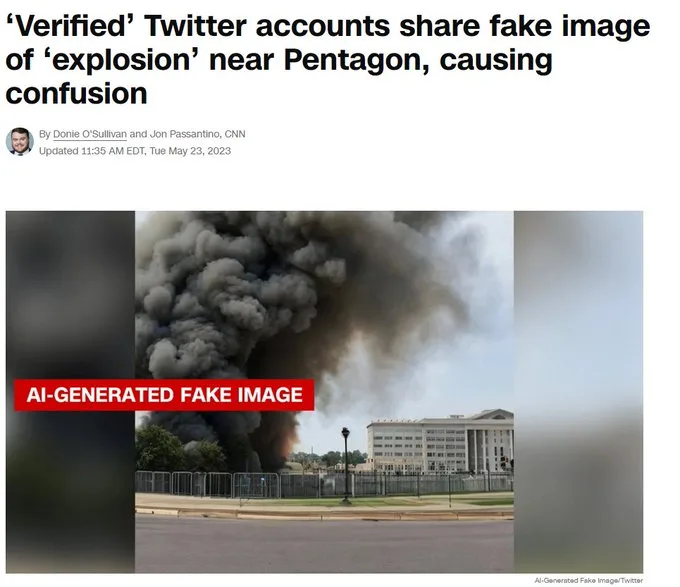The propagation of disinformation has become a major worry in the age of social media. Twitter, one of the most popular social media networks, is addressing this issue by extending its crowdsourced fact-checking program. The most recent advancement incorporates the addition of image context and information, with the goal of combating the viral propagation of false or phony images. This article goes at Twitter’s new Community Notes feature and its possible impact on combating fake news and misinformation.
- Context is Required: Addressing Misleading Images
- Community Notes: Empowering Users to Combat Misinformation
- The Viral Pentagon Incident and the Impact of AI-Generated Images
- Future Expansion: Contextualising Videos and Multiple Images
- Crowdsourced Notes’ Effectiveness in Reducing Misinformation Spread
- The Impact of Twitter’s Corporate Partners on the Stock Market
- Increasing Accountability: Twitter’s Initiative to Combat Misinformation
- Context is Required: Addressing Misleading Images
The dissemination of fake news and misinformation has become a major concern with the expansion of social media platforms. In particular, misleading visuals can elicit powerful emotional responses and have a substantial impact on public perception. Recognizing the importance of dealing with this issue, it has expanded its fact-checking efforts to include photos. Twitter strives to empower people and build a more educated online environment by offering context and confirming the truth of photos.
Table of Contents
Community Notes on Twitter: Empowering Users to Combat Misinformation
Users can provide context to potentially misleading tweets using Twitter’s Community Notes function, formerly known as Birdwatch. It enables people to collaborate on fact-checking and providing extra information in response to erroneous or misleading assertions. Users can now provide context-specific annotations linked to the image highlighted in a tweet by expanding this functionality to images. These annotations will appear beneath matching photographs, assisting users in determining the veracity of the visuals they encounter on the platform.
The Viral Pentagon Incident and the Impact of AI-Generated Images
The rise of AI-generated visuals has exacerbated the problem of disinformation. These graphics, which are frequently indistinguishable from reality, have the potential to confuse consumers and contribute to the rapid spread of fake news. A recent example was a phony photograph of an explosion near the Pentagon that went popular on Twitter. As a result of the occurrence, the stock market experienced a huge fluctuation, highlighting the possible real-world ramifications of such deceptive graphics. The reaction to this occurrence emphasizes the significance of managing the impact of AI-generated photos on the network.
Future Expansion: Contextualising Videos and Multiple Images
While the current Community Notes version focuses on single photos, Twitter recognizes the need to expand this functionality to include films and tweets with multiple images. Recognizing the changing nature of online material, the platform intends to expand its fact-checking skills to include a wider range of media forms. The capacity to provide context and refute disinformation in videos will become increasingly important in creating a more educated online conversation as AI-based video production technology progresses.
Crowdsourced Notes’ Effectiveness in Reducing Misinformation Spread
Twitter’s introduction of Community Notes has demonstrated encouraging results in reducing misinformation dissemination. According to research, people are 15 to 35% less likely to engage with a tweet that has an attached message vs one that does not. This suggests that the appearance of crowdsourced annotations discourages users from liking or retweeting possibly deceptive content. Twitter hopes to develop a more responsible and informed community by utilizing the collective intellect of its user base.
The Impact of Twitter’s Corporate Partners on the Stock Market
Twitter’s corporate partners have taken note of recent viral occurrences involving phony photos, such as the Pentagon explosion. Misinformation’s economic impact was clear in the case of the Pentagon photograph, which produced a huge movement in the stock market. These occurrences highlight the critical need of taking decisive action to counteract the spread of fake news and misleading images. While the intentions behind Twitter’s new policy may be questioned, any effort to reduce misinformation is a positive start.
Promoting Accountability: Twitter’s Initiative to Combat Misinformation
The addition of photographs to Twitter’s crowdsourced fact-checking underlines the platform’s commitment to fostering accountability and preventing the spread of misinformation. Twitter encourages its community to actively participate in the fight against fake news by allowing users to provide context-specific observations. While problems remain, such as the need to handle AI-generated photos and expand the functionality to include videos and multiple images, Twitter’s move is a huge step forward in creating a more trustworthy and educated online environment.
The move to broaden its crowdsourced fact-checking program to include photographs reflects the company’s commitment to tackling disinformation. The platform’s goal is to build a more informed online community by allowing users to offer context-specific notes. The proliferation of AI-generated images, as well as recent viral instances, underline the need of dealing with deceptive visuals. Fact-checking skills are being refined and expanded, paving the path for a more responsible and accountable social media landscape.
Disclaimer:
AI was used to conduct research and help write parts of the article. We primarily use the Gemini model developed by Google AI. While AI-assisted in creating this content, it was reviewed and edited by a human editor to ensure accuracy, clarity, and adherence to Google's webmaster guidelines.





